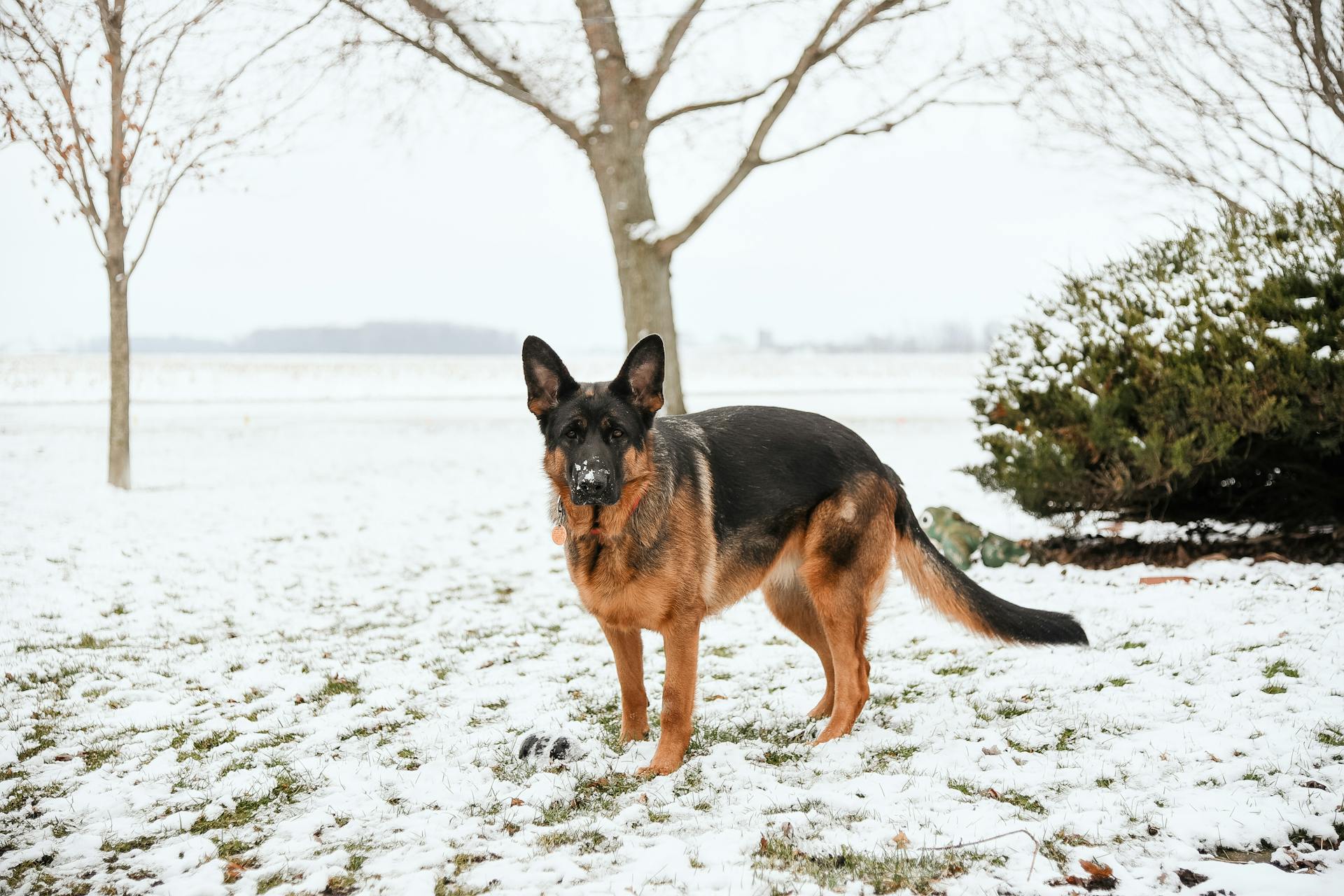
Traveling to France with your furry friend can be a wonderful adventure, but it requires some planning and knowledge of the country's pet requirements. To bring your Category 2 dog into France, you'll need to obtain a health certificate within 10 days of travel.
The health certificate must be issued by an authorized veterinarian and meet the European Union's standards. It's essential to check with your airline for any specific requirements or restrictions on traveling with pets.
France has strict regulations regarding pet travel, so be sure to research and understand the rules before your trip.
Additional reading: Travelling to France with Dogs
Traveling with Pets to France
If you're planning to bring your pet to France, you'll want to know the rules and regulations beforehand. Most visitors to France bring their pets by car, whether driving across the border from a neighbouring EU country or taking the ferry or Eurotunnel from the UK or Ireland.
You must book your pet's ticket in advance when traveling by ferry or train, and there is typically a surcharge. Most ferries and trains allow pets onboard.
Worth a look: Dogs from France
If you're coming from further afield, some airlines do allow dogs, either in the cabin or in the hold, although there are restrictions on some sizes and breeds. Air France-KLM, Delta, British Airways, and Vueling are among the airlines that accept pets.
You'll need to check the airline's rules before booking to ensure they accept your pet. Snub-nosed dogs, such as pugs and bulldogs, may not be able to fly due to restrictions.
Regulations and Requirements
To travel to France with your pet, you'll need to meet certain regulations and requirements. If you're coming from outside the EU, you'll need an Animal Health Certificate (AHC) issued by a certified vet within 10 days of travel, which costs around £100 in the UK.
You'll also need to ensure your pet is microchipped and up-to-date on vaccinations, especially rabies. If you're returning to the UK from France, your pet must be treated for tapeworm within 24 hours to 120 hours of travel.
Dogs are generally welcome in France, but there are some rules to keep in mind. You'll need to keep your dog on a lead in public parks and gardens, and muzzles are required on public transport, at ferry ports, and in some public places.
Related reading: Caniche France
Animal Health Certificate Requirements
If you're traveling to France with your pet from outside the EU, you'll need an Animal Health Certificate (AHC) if you don't have a valid EU pet passport.
You can get an AHC from a certified vet, but first, check if your vet is authorized to issue one. This certificate is required within ten days of travel and needs to be up-to-date with your pet's vaccinations, including rabies.
The cost of an AHC varies by country, but in the UK, it's around £100 (€118). You'll need a new certificate for each trip, but it's valid for four months and can be used for onward travel in the EU.
If you're returning to the UK from France, your pet must be treated for tapeworm within 24 hours to 120 hours of travel. This treatment must be done by a vet, who will issue a certificate or stamp your pet passport.
For your interest: Vet Dogs Dog Treats
What Else Do I Need to Know for Bringing My Dog to France?
Dogs are typically welcomed throughout France, and your furry plus-one will likely be allowed to join you at restaurants, cafés, open-air events, and outdoor markets (although it’s always best to ask first).
French law requires that dogs are kept on a lead in public parks and gardens, and muzzles are required on public transport, at ferry ports, and in some other public places.
Fines may apply for non-compliance, including for owners who fail to pick up after their dog.
If you’re driving in France with your pet, the law states that your pet is restrained in a way so that they cannot interfere with or block the field of vision of the driver, both whilst driving and in the event of an accident – a crate, fixed grill/partition, or seat belt would all suffice.
You'll need to keep an eye out for processionary caterpillars, which are a risk throughout central Europe. If your dog comes into contact with one, rinse their mouth and eyes with water, and take them straight to a vet – the toxins released can be fatal if left untreated, so seeking veterinary advice is essential.
Dangerous" Dogs – Category 1
Category 1 dogs, also known as so-called attack dogs, are crossbreed dogs that can be related morphologically to Staffordshire terriers or American Staffordshire terriers, Mastiffs, or Tosa.
These dogs are prohibited from being purchased, sold, gifted, imported, or introduced into France, unless the owner had acquired the dog before the regulations on dangerous dogs were applied in 2010.
If you acquired a Category 1 dog before 2010, you must hold a detention permit. If the dog is less than 8 months old, a provisional license is issued.
Category 1 dogs must be muzzled and kept on a leash by an adult on public roads and in the common areas of apartment buildings.
You'll also need to have an identification card issued by the central canine society (SCC) or the I-CAD company.
Keep in mind that Category 1 dogs are not allowed in public places, which can limit your activities with your dog.
Category 2 Dogs in France
Category 2 dogs in France are allowed, but with some strict rules. Category 2 dogs are defined as dogs of the Staffordshire terrier or American Staffordshire terrier, Rottweiler, Tosa or assimilated by their morphological characteristics to dogs of the Rottweiler breed, without being registered with the LOF.
These dogs must be muzzled and kept on a leash by an adult on public roads, in public transport, in public places, and in premises open to the public. They must also have the identification card issued by the central canine society (SCC) or the I-CAD society.
You'll need to take out third-party insurance for your Category 2 dog, and proof of this insurance is required. As the owner, you must have an “Attestation d’aptitude” showing that you have received training to own a guard/defence dog.
If you want to travel with a Category 2 dog, you should contact your transport provider prior to travel to find out the rules and whether or not they will be accepted for travel.
Sources
- https://www.angloinfo.com/how-to/france/family/pets-animals/dangerous-dogs
- https://emmenetonchien.com/en/conseils/voyager-avec-chien-categorie-1-2/
- https://uk.ambafrance.org/Introducing-or-reintroducing-my-pet-to-France
- https://www.frenchentree.com/living-in-france/travel/bringing-your-pet-to-france-this-summer-10-quick-answers-to-your-faqs/
- https://www.starwoodpet.com/blog/air-france-pet-policies
Featured Images: pexels.com


